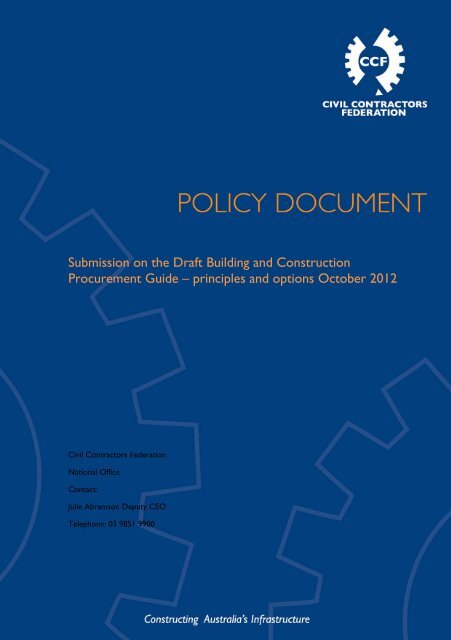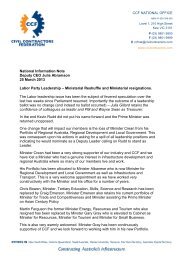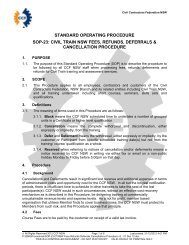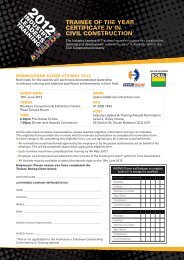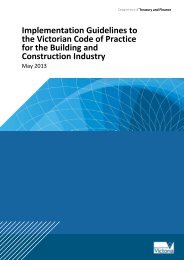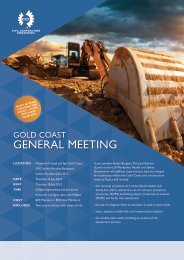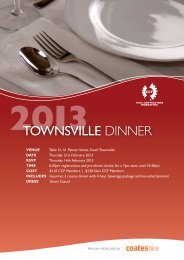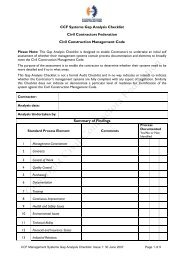Submission on the Draft Building and Construction Procurement Guide
Submission on the Draft Building and Construction Procurement Guide
Submission on the Draft Building and Construction Procurement Guide
You also want an ePaper? Increase the reach of your titles
YUMPU automatically turns print PDFs into web optimized ePapers that Google loves.
<str<strong>on</strong>g>Submissi<strong>on</strong></str<strong>on</strong>g> <strong>on</strong> <strong>the</strong> <strong>Draft</strong> <strong>Building</strong> <strong>and</strong> C<strong>on</strong>structi<strong>on</strong><br />
<strong>Procurement</strong> <strong>Guide</strong> – principles <strong>and</strong> opti<strong>on</strong>s October 2012<br />
Civil C<strong>on</strong>tractors Federati<strong>on</strong><br />
Nati<strong>on</strong>al Office<br />
C<strong>on</strong>tact:<br />
Julie Abrams<strong>on</strong> Deputy CEO<br />
Teleph<strong>on</strong>e: 03 9851 9900
The Civil C<strong>on</strong>tractors Federati<strong>on</strong> (CCF)<br />
The CCF is <strong>the</strong> member based representative body of civil engineering c<strong>on</strong>tractors in<br />
Australia providing assistance <strong>and</strong> expertise in c<strong>on</strong>tractor development <strong>and</strong> industry issues.<br />
Through our Federati<strong>on</strong> we represent over 2000 small, medium <strong>and</strong> large sized c<strong>on</strong>tractors<br />
who in turn work in an industry of more than 350,000 people.<br />
Our members are involved in a variety of projects <strong>and</strong> activities including <strong>the</strong> development<br />
<strong>and</strong> maintenance of civil or “horiz<strong>on</strong>tal” infrastructure such as roads, bridges, sewer, water<br />
<strong>and</strong> drainage pipelines, dams, wharves, commercial <strong>and</strong> housing l<strong>and</strong> development.<br />
Members are also involved in <strong>the</strong> preparatory works for mining <strong>and</strong> o<strong>the</strong>r resource<br />
developments.<br />
We appreciate <strong>the</strong> opportunity to comment <strong>on</strong> <strong>the</strong> draft <strong>Building</strong> <strong>and</strong> C<strong>on</strong>structi<strong>on</strong><br />
<strong>Procurement</strong> <strong>Guide</strong> – principles <strong>and</strong> opti<strong>on</strong>s (“<strong>the</strong> draft guide”).<br />
We note that <strong>the</strong> draft guide “c<strong>on</strong>solidates current jurisdicti<strong>on</strong>-specific approaches to<br />
procurement <strong>and</strong> c<strong>on</strong>tracting of civil (roads <strong>and</strong> bridges) <strong>and</strong> n<strong>on</strong>-residential building works<br />
<strong>and</strong> services into a single overarching framework”. It is not however intended to replace<br />
existing jurisdicti<strong>on</strong>al practices but ra<strong>the</strong>r to supplement <strong>the</strong>m.<br />
Our resp<strong>on</strong>se to this discussi<strong>on</strong> paper c<strong>on</strong>centrates <strong>on</strong> two main areas covered under<br />
Chapter 6 – <strong>Procurement</strong> methods. We have however taken <strong>the</strong> opportunity to raise some<br />
o<strong>the</strong>r matters.<br />
1
1 An introducti<strong>on</strong><br />
As noted <strong>the</strong> CCF submissi<strong>on</strong> in <strong>the</strong> main c<strong>on</strong>centrates <strong>on</strong> Secti<strong>on</strong> 6 – <strong>Procurement</strong><br />
methods. We do however wish to make some general observati<strong>on</strong>s about procurement<br />
strategies as outlined in secti<strong>on</strong> 2 of <strong>the</strong> draft guide.<br />
At <strong>the</strong> outset whilst we welcome <strong>the</strong> work of ARRB, APCC <strong>and</strong> Austroads currently <strong>the</strong>re are<br />
a number of o<strong>the</strong>r projects with similar outcomes covering <strong>the</strong> same space especially in<br />
relati<strong>on</strong> to local government.<br />
By way of example:<br />
• <strong>the</strong> Federal Government has released <strong>the</strong> 2012 Ernst <strong>and</strong> Young Report into<br />
infrastructure financing which in part deals with procurement models 1<br />
• In August this year <strong>the</strong> Victorian Government has just released <strong>the</strong> Victorian Local<br />
Government draft best practice procurement guidelines. 2<br />
• In 2008 Ernst & Young also produced report known as <strong>the</strong> Local Government<br />
<strong>Procurement</strong> Strategy. 3 (“Ernst & Young Report). They were commissi<strong>on</strong>ed by <strong>the</strong><br />
previous Victorian State Government to undertake a detailed assessment of existing<br />
procurement practices employed by councils <strong>and</strong> to identify opportunities for councils to<br />
work in partnership to improve <strong>the</strong>se practices. Ernst & Young c<strong>on</strong>ducted a series of<br />
workshops, interviews <strong>and</strong> detailed data analysis involving more than 40 Councils to<br />
develop <strong>the</strong> Local Government <strong>Procurement</strong> Strategy. The research c<strong>on</strong>clude that <strong>the</strong><br />
adopti<strong>on</strong> of better procurement practices across <strong>the</strong> sector has <strong>the</strong> potential to yield<br />
annual savings in <strong>the</strong> regi<strong>on</strong> of $180-350 milli<strong>on</strong>; <strong>and</strong><br />
• Additi<strong>on</strong>ally, <strong>the</strong>re are also instances in state government where even between state<br />
government agencies <strong>and</strong> departments <strong>the</strong>re are different <strong>and</strong> competing procurement<br />
practices. This adds to complexity <strong>and</strong> <strong>the</strong> cost of doing business.<br />
In our view what is missing in a number of <strong>the</strong>se projects (which we support) is a practical<br />
emphasis <strong>on</strong> “<strong>the</strong> how to.” for example what are <strong>the</strong> practices in various authorities that<br />
would make <strong>the</strong>se principles “live <strong>and</strong> brea<strong>the</strong>”. 4<br />
1 Ernst & Young Str<strong>on</strong>g foundati<strong>on</strong>s for sustainable local government infrastructure available at<br />
http://www.regi<strong>on</strong>al.gov.au/local/lgifr/files/20120622-str<strong>on</strong>g-foundati<strong>on</strong>s.pdf<br />
2 Victorian Local Government <strong>Draft</strong> Best Practice <strong>Procurement</strong> <strong>Guide</strong>lines August 2012 available at<br />
www.dpcd.vic.gov.au<br />
3 Ernst &Young Local Government <strong>Procurement</strong> Strategy at<br />
http://www.dpcd.vic.gov.au/__data/assets/pdf_file/0016/52225/2008-Local-Government-<strong>Procurement</strong>-<br />
Strategy.pdf<br />
4 Particularly in relati<strong>on</strong> to local government as <strong>the</strong> above reports indicate<br />
2
We have made <strong>the</strong> point <strong>on</strong> a number of occasi<strong>on</strong>s that loss of <strong>and</strong> shortage of engineering<br />
<strong>and</strong> like skills is negatively impacting infrastructure development.<br />
For this reas<strong>on</strong> <strong>the</strong> best practice guide for tendering <strong>and</strong> c<strong>on</strong>tract management developed in<br />
by 2007 CCF (Victoria) in c<strong>on</strong>juncti<strong>on</strong> with <strong>the</strong> Institute of Public Works Engineering<br />
Australia <strong>and</strong> <strong>the</strong> Municipal Associati<strong>on</strong> of Victoria is an important body of work <strong>and</strong> we are<br />
looking fur<strong>the</strong>r at updating <strong>and</strong> reviewing it in view of recent developments.<br />
2 <strong>Procurement</strong> Methods<br />
In this secti<strong>on</strong> we resp<strong>on</strong>d to <strong>the</strong> issues raised in Chapter 6 in particular in relati<strong>on</strong> to form of<br />
c<strong>on</strong>tract, <strong>the</strong> procurement process <strong>and</strong> o<strong>the</strong>r factors such as c<strong>on</strong>tract administrati<strong>on</strong><br />
requirements or bundling.<br />
2.1 Forms of c<strong>on</strong>tract<br />
As noted in <strong>the</strong> frequently asked questi<strong>on</strong>s document (FAQ) 5 variability in c<strong>on</strong>tract<br />
documentati<strong>on</strong> <strong>and</strong> management is a c<strong>on</strong>siderable <strong>and</strong> <strong>on</strong>going source of c<strong>on</strong>cern for our<br />
members.<br />
2.1.1 Variability in C<strong>on</strong>tract documentati<strong>on</strong><br />
Directly <strong>on</strong> this point in our recent submissi<strong>on</strong> to <strong>the</strong> Productivity Commissi<strong>on</strong> Inquiry into<br />
local government as Regulator 6 we noted that <strong>on</strong>e of <strong>the</strong> major c<strong>on</strong>cerns of <strong>the</strong> civil sector is<br />
in relati<strong>on</strong> to lack of st<strong>and</strong>ardisati<strong>on</strong>.<br />
This a broad ranging issue as it starts with <strong>the</strong> tender <strong>and</strong> procurement process, includes <strong>the</strong><br />
c<strong>on</strong>tract process, technical specificati<strong>on</strong>s <strong>and</strong> <strong>on</strong> site management. We deal with this later<br />
point in 2.1.2 below.<br />
In terms of <strong>the</strong> c<strong>on</strong>tractual process, previous research has highlighted that anecdotally in<br />
<strong>on</strong>e state al<strong>on</strong>e <strong>the</strong>re are over 60 different general c<strong>on</strong>diti<strong>on</strong>s of c<strong>on</strong>tract. 7<br />
This adds complexity <strong>and</strong> cost to c<strong>on</strong>tractors as <strong>the</strong>y need to be able to underst<strong>and</strong> <strong>and</strong><br />
interpret complex c<strong>on</strong>tracts which can differ between even neighbouring councils, shires <strong>and</strong><br />
authorities as well as c<strong>on</strong>sulting engineers sometimes in relati<strong>on</strong> to similar projects.<br />
5 See <strong>Draft</strong> <strong>Building</strong> <strong>and</strong> C<strong>on</strong>structi<strong>on</strong> <strong>Procurement</strong> <strong>Guide</strong> – principles <strong>and</strong> opti<strong>on</strong>s at http://austroads.com.au<br />
6 Our submissi<strong>on</strong> to <strong>the</strong> <strong>Draft</strong> Productivity Commissi<strong>on</strong> Report into Performance Benchmarking Role of Local<br />
Government as regulator is available at www.pc.gov.au. The Commissi<strong>on</strong> has also now released its final<br />
Report.<br />
7 Our comments in this regard are picked up in <strong>the</strong> Final Report at page 105<br />
3
Not all of this cost can be passed <strong>on</strong> which is ano<strong>the</strong>r impediment to business growth.<br />
We have noted with interest <strong>the</strong> comments in <strong>the</strong> FAQ that <strong>the</strong>re is actually a debate about<br />
whe<strong>the</strong>r st<strong>and</strong>ardisati<strong>on</strong> is necessary or ra<strong>the</strong>r “...c<strong>on</strong>sistency of approach based <strong>on</strong><br />
comm<strong>on</strong> risk-sharing processes” would be a better outcome.”<br />
We support in principle efforts to set forward some high level principles as a way at <strong>the</strong> very<br />
least of working towards c<strong>on</strong>sistency of approach although we cauti<strong>on</strong> that any guidance in<br />
this area has to be flexible enough to encompass <strong>and</strong> resp<strong>on</strong>d to local c<strong>on</strong>diti<strong>on</strong>s.<br />
We made this point in our recent submissi<strong>on</strong> <strong>on</strong> prequalificati<strong>on</strong> noting:<br />
“There needs to be flexibility at a local or state level to deal with local issues to ensure that<br />
smaller c<strong>on</strong>tractors in particular are competing <strong>on</strong> a level playing field. Flexibility is<br />
particularly critical in relati<strong>on</strong> to <strong>the</strong> harm<strong>on</strong>isati<strong>on</strong> principles – what is appropriate in <strong>on</strong>e<br />
jurisdicti<strong>on</strong> may be for local reas<strong>on</strong>s not appropriate in ano<strong>the</strong>r.<br />
In o<strong>the</strong>r words our support for mutual recogniti<strong>on</strong> <strong>and</strong> harm<strong>on</strong>isati<strong>on</strong> are not without<br />
qualificati<strong>on</strong>.” 8<br />
It would also be appropriate in <strong>the</strong> c<strong>on</strong>text of this draft guide to make some more general<br />
remarks about <strong>the</strong> current use of st<strong>and</strong>ard form c<strong>on</strong>tracts <strong>and</strong> in particular AS 4000 which<br />
was <strong>the</strong> subject of a recent submissi<strong>on</strong> to <strong>the</strong> Federal Attorney-General’s Review of<br />
Australian C<strong>on</strong>tract Law. 9<br />
2.1.2 The role of st<strong>and</strong>ard form c<strong>on</strong>tracts<br />
We note <strong>the</strong>re is great variability in <strong>the</strong> st<strong>and</strong>ard from c<strong>on</strong>tracts used dependent <strong>on</strong> <strong>the</strong><br />
jurisdicti<strong>on</strong>. We also note <strong>the</strong> comment in <strong>the</strong> draft guide that whilst:<br />
“AS 4000-1997, which is <strong>the</strong> st<strong>and</strong>ard form that replaced AS 2124-1992 is also available for<br />
use. However, it has not been widely taken up by member agencies, particularly in <strong>the</strong> civil<br />
(road bridge sector).” 10<br />
Top end or larger projects tend to be <strong>the</strong> subject of separate “be-spoke” c<strong>on</strong>tracts often<br />
between parties with similar bargaining positi<strong>on</strong>s however <strong>the</strong> st<strong>and</strong>ard form c<strong>on</strong>tract still<br />
plays a significant role for some of our medium <strong>and</strong> smaller sized members.<br />
8 The CCF submissi<strong>on</strong> <strong>on</strong> prequalificati<strong>on</strong> lodged in October is available <strong>on</strong> request.<br />
9 The CCF submissi<strong>on</strong> to <strong>the</strong> Federal Attorney –General’s review of c<strong>on</strong>tract law is available <strong>on</strong> request.<br />
10 See page 39<br />
4
Whilst <strong>the</strong>re are regi<strong>on</strong>al variati<strong>on</strong>s dependent <strong>on</strong> <strong>the</strong> client/procuring authority a number of<br />
members are parties to <strong>the</strong> 4000 series c<strong>on</strong>tracts <strong>and</strong> have raised issues with us in relati<strong>on</strong><br />
to AS 4000 – 1997 General C<strong>on</strong>diti<strong>on</strong>s of c<strong>on</strong>tract<br />
Whilst members in principle support <strong>the</strong> practicality <strong>and</strong> usefulness of st<strong>and</strong>ard form<br />
c<strong>on</strong>tracts difficulties do arise in relati<strong>on</strong> to <strong>the</strong> interpretati<strong>on</strong>, c<strong>on</strong>structi<strong>on</strong> <strong>and</strong> workability of<br />
this series particularly given modern developments as noted in <strong>the</strong> draft guide.<br />
In particular, in some cases members report to us of c<strong>on</strong>tracts which purport to be AS –<br />
4000 based c<strong>on</strong>tracts <strong>and</strong> yet c<strong>on</strong>tain rafts of special c<strong>on</strong>diti<strong>on</strong>s <strong>and</strong> exclusi<strong>on</strong>s which<br />
change <strong>the</strong> whole basis of <strong>the</strong> c<strong>on</strong>tract.<br />
We note that in developing <strong>the</strong> draft guide this point was also made to <strong>the</strong> Review group<br />
“ Additi<strong>on</strong>ally, for c<strong>on</strong>tracts at all values <strong>the</strong> merits of appending voluminous supplementary<br />
or “special c<strong>on</strong>diti<strong>on</strong>s” to st<strong>and</strong>ard form c<strong>on</strong>tracts such as AS 2124 -1992 were questi<strong>on</strong>ed in<br />
some of <strong>the</strong> submissi<strong>on</strong>s with a suggesti<strong>on</strong> that <strong>the</strong>se be minimised wherever possible.” 11<br />
For smaller members without significant resources this practice can be problematic as <strong>the</strong>y<br />
may have little bargaining power or ability to influence <strong>the</strong> c<strong>on</strong>tract negotiati<strong>on</strong> if <strong>the</strong>y want<br />
<strong>the</strong> work <strong>the</strong> subject of <strong>the</strong> c<strong>on</strong>tract.<br />
We also str<strong>on</strong>gly agree with <strong>the</strong> following comments in <strong>the</strong> draft guide:<br />
“St<strong>and</strong>ard form c<strong>on</strong>tracts are popular am<strong>on</strong>gst project owners <strong>and</strong> industry because <strong>the</strong>ir<br />
use helps reduce procurement <strong>and</strong> c<strong>on</strong>tract administrati<strong>on</strong> costs <strong>and</strong> <strong>the</strong>y are generally well<br />
understood by users, <strong>the</strong>reby resulting in fewer disputes or matters of interpretati<strong>on</strong>. This<br />
advantage may, however be reduced when amendments <strong>and</strong> supplementary or “special”<br />
c<strong>on</strong>diti<strong>on</strong>s are included that significantly alter <strong>the</strong> st<strong>and</strong>ard general c<strong>on</strong>diti<strong>on</strong>s.” 12<br />
Risk, indemnity, c<strong>on</strong>sequential loss, payments terms, latent c<strong>on</strong>diti<strong>on</strong>s, accepted causes of<br />
delay <strong>and</strong> subsequent extensi<strong>on</strong> of time, time bars <strong>and</strong> insurance provisi<strong>on</strong>s are comm<strong>on</strong>ly<br />
altered in favour of <strong>the</strong> procuring party through this process.<br />
Whilst we support efforts towards comm<strong>on</strong> principles we are c<strong>on</strong>cerned as to whe<strong>the</strong>r this<br />
will result in better outcomes for members as in <strong>the</strong> end it will come down to <strong>the</strong> actual<br />
c<strong>on</strong>tracting terms as well as <strong>the</strong> “mind set” of <strong>the</strong> procuring agencies.<br />
11 See FAQ at page 6<br />
12 See draft guide at page 38<br />
5
2.1.3 C<strong>on</strong>tract administrati<strong>on</strong> issues<br />
Clearly whilst <strong>the</strong>re are issues in relati<strong>on</strong> to form <strong>and</strong> c<strong>on</strong>tent of c<strong>on</strong>tracts <strong>on</strong>e of <strong>the</strong> main<br />
areas of c<strong>on</strong>cern is also in relati<strong>on</strong> to c<strong>on</strong>tract administrati<strong>on</strong>.<br />
We note that <strong>the</strong> frequently asked questi<strong>on</strong>s (FAQ) docment provides a very good snapshot<br />
of issues in <strong>the</strong> existing variability in c<strong>on</strong>tract documentati<strong>on</strong> <strong>and</strong> management<br />
administrati<strong>on</strong> where it is stated:<br />
“Specific issues cited were:<br />
• An apparent lack of informed choice of procurement methods <strong>and</strong> c<strong>on</strong>tract<br />
instruments<br />
• Poor attenti<strong>on</strong> to detail in c<strong>on</strong>tract documentati<strong>on</strong><br />
• Project owner pers<strong>on</strong>nel lacking appropriate c<strong>on</strong>tract management experience.” 13<br />
Whilst we fully support <strong>the</strong>se points in our view <strong>the</strong> issues are actually broader <strong>and</strong> include<br />
inappropriate regulatory c<strong>on</strong>trols, inc<strong>on</strong>sistent applicati<strong>on</strong>s of st<strong>and</strong>ards, over-engineering,<br />
unnecessary processes <strong>and</strong> poor tendering <strong>and</strong> c<strong>on</strong>tract management practices all of which<br />
impact negatively up<strong>on</strong> civil c<strong>on</strong>structi<strong>on</strong> activities such as <strong>the</strong> c<strong>on</strong>structi<strong>on</strong> of subdivisi<strong>on</strong>s<br />
<strong>and</strong> road infrastructure.<br />
This has a real cost to <strong>the</strong> community as <strong>the</strong> Ernst & Young Report found <strong>the</strong> adopti<strong>on</strong> of<br />
better procurement practices across <strong>the</strong> sector has <strong>the</strong> potential to yield annual savings in<br />
<strong>the</strong> regi<strong>on</strong> of $180-350 milli<strong>on</strong>. Our own research has also indicated that:<br />
“CCF Victorian members in 2009 believed that in some instances, subdivisi<strong>on</strong> c<strong>on</strong>structi<strong>on</strong><br />
costs could be reduced by upwards of 10% through <strong>the</strong> removal of <strong>the</strong> impediments to <strong>the</strong><br />
efficient delivery of infrastructure. This equates to approximately $8,000 per house allotment.<br />
That cost anecdotally is now likely to be between $9000 <strong>and</strong> $10,000 an allotment.” 14<br />
The issues raised in <strong>the</strong> draft guide were also highlighted in relati<strong>on</strong> to <strong>the</strong> AS 4000 General<br />
C<strong>on</strong>diti<strong>on</strong>s of C<strong>on</strong>tract where problems for members included in relati<strong>on</strong> to payment<br />
schedules, <strong>the</strong> role of superintendents, retenti<strong>on</strong> of payments <strong>and</strong> bank guarantees, practical<br />
completi<strong>on</strong> <strong>and</strong> lack of engineering skills particularly in local government.<br />
Where appropriate we comment <strong>on</strong> this in relati<strong>on</strong> to <strong>the</strong> c<strong>on</strong>tracting principles outlined in <strong>the</strong><br />
next secti<strong>on</strong>.<br />
13 FAQ at page 6<br />
14 This submissi<strong>on</strong> is available <strong>on</strong> request or pc.gov.au<br />
6
2.2 C<strong>on</strong>tracting Principles<br />
In general terms we support <strong>the</strong> c<strong>on</strong>tracting principles as we have noted previously <strong>the</strong> issue<br />
we see is more in providing support <strong>on</strong> <strong>the</strong> “How to” by way of some good practices already<br />
in procuring agencies.<br />
We would however like to make some more detailed commentary <strong>on</strong> several of <strong>the</strong><br />
principles.<br />
2.2.1 General principles<br />
(a)<br />
<strong>Procurement</strong> method<br />
See our comments in relati<strong>on</strong> to st<strong>and</strong>ard form c<strong>on</strong>tracts above in 2.1.<br />
(b)<br />
Innovati<strong>on</strong><br />
Whilst we support any provisi<strong>on</strong> to encourage innovati<strong>on</strong> c<strong>on</strong>tractors actually need to be<br />
rewarded for innovati<strong>on</strong>. There are at least three factors to c<strong>on</strong>sider.<br />
Firstly, <strong>on</strong>e of <strong>the</strong> c<strong>on</strong>sistent complaints of CCF members is that tenders are often <strong>on</strong>ly<br />
awarded <strong>on</strong> a “lowest price basis” <strong>and</strong> o<strong>the</strong>r relevant factors such as sustainable<br />
c<strong>on</strong>structi<strong>on</strong> methods, training <strong>and</strong> development commitments, third party endorsements or<br />
innovative practices are not taken into account.<br />
Such an approach particularly disadvantages small to medium c<strong>on</strong>tractors who because of<br />
<strong>the</strong>ir size might have unique expertise or innovative approaches which are not recognized in<br />
a “price al<strong>on</strong>e” model.<br />
Sec<strong>on</strong>dly, <strong>the</strong> loss of engineering skills particularly in local government works against<br />
supporting innovative methods of c<strong>on</strong>structi<strong>on</strong>.<br />
Our members comm<strong>on</strong>ly refer to <strong>the</strong> over engineering <strong>and</strong> over specificati<strong>on</strong> issues as<br />
requiring a Rolls Royce soluti<strong>on</strong> when o<strong>the</strong>r more practical <strong>and</strong> efficient soluti<strong>on</strong>s are at<br />
h<strong>and</strong>. C<strong>on</strong>tractors tended to be very pragmatic about this putting this down to <strong>the</strong> current<br />
“risk averse” approach of authorities or <strong>the</strong>ir c<strong>on</strong>sultants.<br />
One of our members related to us an example where his company was required to c<strong>on</strong>struct<br />
<strong>and</strong> install drainage pits to what was regarded as <strong>the</strong> most expensive opti<strong>on</strong> notwithst<strong>and</strong>ing<br />
that from an engineering point of view in our member’s judgement this was totally<br />
unnecessary.<br />
7
This also raises a c<strong>on</strong>necti<strong>on</strong> with tendering. If c<strong>on</strong>tractors are asked to tender to particular<br />
technical specificati<strong>on</strong>s <strong>the</strong>y will do so as failure to do so will result in a n<strong>on</strong>-c<strong>on</strong>forming<br />
tender.<br />
Lastly, <strong>the</strong> ability to innovate is directly related to <strong>the</strong> flexibility in <strong>the</strong> design elements, <strong>the</strong><br />
time available to tender <strong>and</strong> <strong>the</strong> willingness to explore alternatives that meet <strong>the</strong><br />
performance requirements.<br />
It is a comm<strong>on</strong> scenario that <strong>the</strong> design is finalised <strong>and</strong> <strong>the</strong> procurer is unwilling or even<br />
unable to c<strong>on</strong>sider alternatives, <strong>the</strong> tender time is very short <strong>and</strong> / or <strong>the</strong> performance<br />
specificati<strong>on</strong>s are not provided <strong>and</strong> so alternatives are difficult to provide.<br />
So whilst we str<strong>on</strong>gly support this goal in principle much work will need to be undertaken for<br />
<strong>the</strong>re to be practical outcomes.<br />
(c)<br />
Risk Allocati<strong>on</strong><br />
Some comments <strong>on</strong> <strong>the</strong> general principles<br />
Whilst <strong>the</strong> risk allocati<strong>on</strong> principle is sound <strong>the</strong>re has been a c<strong>on</strong>tinuing tendency to shift<br />
“risk” towards c<strong>on</strong>tractors <strong>and</strong> it is difficult to see how <strong>the</strong> principle will in our view<br />
“rebalance” <strong>the</strong> pendulum.<br />
Whilst we support <strong>the</strong> principle – “place <strong>the</strong> risk where <strong>the</strong> risk is best managed”. In our view<br />
that has also been applied out of c<strong>on</strong>text.<br />
As noted in relati<strong>on</strong> to st<strong>and</strong>ard form c<strong>on</strong>tracts in practice <strong>the</strong>se are rarely st<strong>and</strong>ard <strong>and</strong> <strong>the</strong><br />
substantial amendments are often to do with changing risk allocati<strong>on</strong>, indemnity provisi<strong>on</strong>s<br />
<strong>and</strong> insurance from <strong>the</strong> procuring party/client to <strong>the</strong> c<strong>on</strong>tractor.<br />
Risk by its very definiti<strong>on</strong> is a ‘possibility’ <strong>and</strong> not a ‘probability’. Managing a risk (or<br />
managing a possible event) in a c<strong>on</strong>tract sense is about being adaptable <strong>and</strong> resilient as<br />
well as being capable of dealing with <strong>the</strong> inevitable uncertainty.<br />
As an industry our best project managers are probably <strong>the</strong> best at dealing with this<br />
uncertainty <strong>and</strong> being able to react to a possible event actually occurring in a manner that is<br />
safe <strong>and</strong> cost effective. It is however <strong>the</strong> experience of <strong>the</strong> industry that managing risk is<br />
often not about <strong>the</strong> project manager’s ability to deal with uncertainty but ra<strong>the</strong>r it is about<br />
cost.<br />
8
By way of illustrati<strong>on</strong> Clients often transfer uncertainty of scope <strong>and</strong> / or thus cost to <strong>the</strong><br />
C<strong>on</strong>tractor but do this <strong>on</strong> <strong>the</strong> premise that ‘<strong>the</strong> C<strong>on</strong>tractor can manage <strong>the</strong> uncertainty’.<br />
Whilst this is often <strong>the</strong> case <strong>the</strong> difficulty is that if <strong>the</strong> risk can’t be quantified than how can<br />
<strong>the</strong> cost be managed. So what happens in practice is that risk is priced <strong>on</strong> a set of unknown<br />
variables which may or may not be appropriate. This of course adds to cost in a project <strong>and</strong><br />
if <strong>the</strong> c<strong>on</strong>tractors judgment is wr<strong>on</strong>g this can have a devastating impact <strong>on</strong> <strong>the</strong>ir business.<br />
A good example of how this works in practice is utility relocati<strong>on</strong> costs. Many times <strong>the</strong><br />
works that civil c<strong>on</strong>tractors undertake cannot be started until <strong>the</strong> utilities have relocated <strong>the</strong>ir<br />
water, gas or power lines. The utilities have a ‘no risk’ policy – that is if <strong>the</strong> c<strong>on</strong>tractor needs<br />
<strong>the</strong> pipes moved <strong>the</strong>n an estimate will be provided but <strong>the</strong> ultimate costs will passed <strong>on</strong> in<br />
full. However, <strong>the</strong> client invariably requires that <strong>the</strong> civil c<strong>on</strong>tractor fix <strong>the</strong>ir cost at tender<br />
time, often citing that this risk is best managed by <strong>the</strong> C<strong>on</strong>tractor.<br />
The bottom line is C<strong>on</strong>tractors can deal with uncertainty <strong>and</strong> resp<strong>on</strong>d with cost effective<br />
soluti<strong>on</strong>s. But <strong>the</strong>y should not be put in <strong>the</strong> positi<strong>on</strong> of having to quantify a cost which at that<br />
stage is unquantifiable <strong>and</strong> hence to price in a risk that cannot be costed.<br />
C<strong>on</strong>tracts like AS2124 <strong>and</strong> AS4000 have legitimate principles that apply to <strong>the</strong> management<br />
of items where <strong>the</strong> scope isn’t known for example provisi<strong>on</strong>al sums but <strong>the</strong>se are routinely<br />
altered in favor of <strong>the</strong> client or procuring agency.<br />
Additi<strong>on</strong>ally our members also report instances to us of “having to wear” what <strong>the</strong>y regard as<br />
a greater risk in circumstances where <strong>the</strong>y cannot mitigate it. For example being provided<br />
with specificati<strong>on</strong>s which <strong>the</strong>y can’t change <strong>and</strong> which carry significant design risk <strong>and</strong> <strong>the</strong>n<br />
when a design fault causes loss being held liable.<br />
Risk allocati<strong>on</strong>, PPP <strong>and</strong> Alliance c<strong>on</strong>tracting<br />
The way risk is allocated is of course a particular feature of a PPP which parties are aware<br />
of when <strong>the</strong>y undertake <strong>the</strong> project however it remains essential that <strong>the</strong>re are clearly<br />
defined roles <strong>and</strong> resp<strong>on</strong>sibilities for <strong>the</strong> parties which identifies <strong>the</strong> management for each<br />
key risk.<br />
We would also like to make some comments about alliance c<strong>on</strong>tracting. World-wide<br />
experience underscores that effective alliances involve <strong>the</strong> “share <strong>the</strong> gain share <strong>the</strong> pain”<br />
across <strong>the</strong> entire supply chain of alliances.<br />
However, unfortunately a number of our members have had experiences of alliance<br />
c<strong>on</strong>tracts which do not deliver <strong>the</strong> benefits to all parties equally.<br />
9
It is our view that Government <strong>and</strong> Government agencies can <strong>and</strong> should structure <strong>the</strong>ir<br />
alliance c<strong>on</strong>tracts in such a way that all entities in <strong>the</strong> supply chain are encouraged to pursue<br />
collectively <strong>the</strong> benefits implicit in such c<strong>on</strong>tracts. We note with some interest <strong>the</strong><br />
development of <strong>the</strong> “Project Alliance Agreement” template.<br />
(d)<br />
Limitati<strong>on</strong> of liability, warranties, indemnities <strong>and</strong> Insurances<br />
These principles appear sound but <strong>on</strong>ce again <strong>the</strong> proof will be in c<strong>on</strong>tracting outcomes.<br />
Some of <strong>the</strong> practical issues for c<strong>on</strong>tractors are outlined below.<br />
Warranties (<strong>and</strong> defect liability)<br />
C<strong>on</strong>tractors are experiencing an increasing timeframe for expiry of <strong>the</strong> defects liability<br />
period. This has shifted over time from 6 m<strong>on</strong>ths, to 12 m<strong>on</strong>ths <strong>and</strong> now in some cases 24<br />
m<strong>on</strong>ths.<br />
This comes at a cost to <strong>the</strong> c<strong>on</strong>tractor because in practical terms some security will remain<br />
in place whe<strong>the</strong>r through retenti<strong>on</strong> of payments or a c<strong>on</strong>diti<strong>on</strong>al bank guarantee. In some<br />
cases <strong>the</strong> c<strong>on</strong>tractor can price for this <strong>and</strong> pass <strong>the</strong> cost <strong>on</strong> impacting <strong>the</strong> overall cost of<br />
projects in o<strong>the</strong>rs it reduces already slim margins.<br />
Additi<strong>on</strong>ally, c<strong>on</strong>tractors report being reviewed in relati<strong>on</strong> to financial capacity by procuring<br />
agencies because <strong>the</strong>y have had to hold financial surety in relati<strong>on</strong> to a number of<br />
completed projects for extensive periods of time. This acts as a brake <strong>on</strong> business<br />
productivity <strong>and</strong> growth particularly in <strong>the</strong> mid-sector as well as limiting <strong>the</strong> functi<strong>on</strong>ing of a<br />
truly competitive market (i.e. by removing some participants).<br />
Insurances <strong>and</strong> unlimited liability<br />
Once again <strong>the</strong> principle is sound. The practical experience of c<strong>on</strong>tractors is that over time<br />
<strong>the</strong> amount of insurance for example in public liability has exp<strong>and</strong>ed from $5 milli<strong>on</strong>, to $10<br />
milli<strong>on</strong> <strong>and</strong> now routinely $20 milli<strong>on</strong>.<br />
In some cases this results in projects being over insured as each c<strong>on</strong>tractor takes out<br />
insurance. It also flows through <strong>the</strong> c<strong>on</strong>tracting chain. By way of example if <strong>the</strong>re is state<br />
funding in a project <strong>the</strong> state government will require certain levels of insurance, <strong>the</strong> local<br />
government will also require insurances <strong>and</strong> finally <strong>the</strong> head c<strong>on</strong>tractor. This also <strong>the</strong>n<br />
becomes <strong>the</strong> industry norm.<br />
10
(e)<br />
Key Pers<strong>on</strong>nel<br />
We are very str<strong>on</strong>gly supportive of <strong>the</strong> principle “c<strong>on</strong>tract pers<strong>on</strong>nel are to have skills <strong>and</strong><br />
experience appropriate to <strong>the</strong>ir roles”.<br />
This is a key issue identified by members.<br />
In 2009 <strong>the</strong> CT Management Group was engaged by CCF to undertake a research project<br />
aimed at assessing <strong>the</strong> impediments to <strong>the</strong> efficient delivery of subdivisi<strong>on</strong>s <strong>and</strong> road<br />
infrastructure. 15<br />
The research project involved face-to-face interviews with 20 CCF members actively<br />
involved in <strong>the</strong> provisi<strong>on</strong> of subdivisi<strong>on</strong>s <strong>and</strong> road infrastructure.<br />
In that Report <strong>on</strong>e of <strong>the</strong> findings of that research was that:<br />
“Authorities were losing <strong>the</strong> older more experienced supervisors <strong>and</strong> replacing <strong>the</strong>se with<br />
younger less experienced pers<strong>on</strong>nel. Many c<strong>on</strong>tractors felt that authorities needed to<br />
improve successi<strong>on</strong> planning <strong>and</strong> programs to pass <strong>on</strong> <strong>the</strong> experience to younger<br />
pers<strong>on</strong>nel.” 16<br />
We have previously indicated that in our view much of <strong>the</strong> over-engineering <strong>and</strong> over<br />
specificati<strong>on</strong> is directly referrable to <strong>the</strong> loss of engineering skills particularly in local<br />
government.<br />
In an envir<strong>on</strong>ment of acute skills shortages especially in engineering this is not easily<br />
resolved. However, <strong>the</strong>re are soluti<strong>on</strong>s to this which include involving <strong>the</strong> c<strong>on</strong>tractor in <strong>the</strong><br />
early stages of a project <strong>and</strong> in <strong>the</strong> design <strong>and</strong> c<strong>on</strong>structi<strong>on</strong>.<br />
(f)<br />
Subc<strong>on</strong>tracting<br />
As <strong>the</strong> <strong>Guide</strong> prop<strong>on</strong>ents would be aware CCF as a matter of principle supports unbundling<br />
<strong>and</strong> de-aggregati<strong>on</strong> of works so that all levels of <strong>the</strong> c<strong>on</strong>tracting market have <strong>the</strong> ability to<br />
grow. Therefore a prohibiti<strong>on</strong> <strong>on</strong> sub-c<strong>on</strong>tracting <strong>the</strong> whole of <strong>the</strong> works should in <strong>the</strong>ory<br />
assist our smaller to medium sized members to tender for work in that own right although in<br />
some procuring agencies this would also require a shift in <strong>the</strong> “procuring culture”.<br />
Unbundling of c<strong>on</strong>tracts is not <strong>the</strong> <strong>on</strong>ly issue as small <strong>and</strong> medium sized c<strong>on</strong>tractors can<br />
also be severely disadvantaged by <strong>the</strong> way c<strong>on</strong>tracts are structured, tendering processes,<br />
15 This Report is available <strong>on</strong> request<br />
16 2009 Report at page 3<br />
11
<strong>the</strong> prequalificati<strong>on</strong> system <strong>and</strong> <strong>the</strong> failure of procurement agencies to properly plan through<br />
rolling <strong>and</strong> forward capital programs.<br />
We deal with this in more detail in our resp<strong>on</strong>se to 6.6 of <strong>the</strong> draft guide.<br />
(g)<br />
Dispute resoluti<strong>on</strong><br />
We str<strong>on</strong>gly support <strong>the</strong> principles in relati<strong>on</strong> to dispute resoluti<strong>on</strong>.<br />
There is research available which seeks to quantify <strong>the</strong> cost of disputes. For example <strong>the</strong><br />
CRC C<strong>on</strong>structi<strong>on</strong> Innovati<strong>on</strong> Study <strong>on</strong>”Dispute Avoidance <strong>and</strong> Resoluti<strong>on</strong>” 17 . That study<br />
found that <strong>on</strong> an analysis of available industry data regarding <strong>the</strong> direct cost of resolving<br />
disputes, <strong>and</strong> feedback from clients, c<strong>on</strong>tractors <strong>and</strong> legal practiti<strong>on</strong>ers:<br />
“…that an industry-wide general magnitude estimate of <strong>the</strong> direct cost<br />
of resolving disputes of between about $560 milli<strong>on</strong> <strong>and</strong> $840 milli<strong>on</strong> per year.<br />
When <strong>the</strong> direct cost of resolving disputes is added to <strong>the</strong> avoidable costs, <strong>the</strong> total waste<br />
exceeds $7 billi<strong>on</strong> per year, given c<strong>on</strong>structi<strong>on</strong> industry turnover of $120 billi<strong>on</strong> in 2008-09. 18<br />
The Aurec<strong>on</strong> 2009 Report Achieving Civil Infrastructure <strong>Procurement</strong> Best Practice - a study<br />
by Civil C<strong>on</strong>tractor’s Federati<strong>on</strong> in c<strong>on</strong>juncti<strong>on</strong> with VicRoads (<strong>the</strong> Aurec<strong>on</strong> Report) 19 also<br />
noted:<br />
“The time, effort <strong>and</strong> energy spent <strong>on</strong> resolving claims <strong>and</strong> disputes represents an<br />
opportunity cost to <strong>the</strong> civil infrastructure industry. If <strong>the</strong>se costs can be avoided by<br />
appropriate attitudes <strong>and</strong> practices <strong>the</strong> same resource pool is capable of producing<br />
more public <strong>and</strong> private infrastructure for <strong>the</strong> benefit of <strong>the</strong> community as a whole.<br />
Traditi<strong>on</strong>al methods of dispute resoluti<strong>on</strong> are adversarial in nature <strong>and</strong> do not start until <strong>the</strong><br />
parties have developed c<strong>on</strong>trary positi<strong>on</strong>s <strong>and</strong> a difference or dispute has<br />
crystallised.<br />
Today’s best practice requires proactive issue resoluti<strong>on</strong> processes to be employed that<br />
attempt to resolve issues as <strong>the</strong>y arise <strong>and</strong> before a dispute forms. That is proactive issue<br />
resoluti<strong>on</strong> seeks to resolve claims as well as disputes.” 20<br />
17 CRC C<strong>on</strong>structi<strong>on</strong> Innovati<strong>on</strong> Study <strong>on</strong> ”Dispute Avoidance <strong>and</strong> Resoluti<strong>on</strong>” available at www.c<strong>on</strong>structi<strong>on</strong>innovati<strong>on</strong>.info<br />
18 Ibid Page 3<br />
19 The Aurec<strong>on</strong> report is available <strong>on</strong> request<br />
20 See Page ix of <strong>the</strong> Report<br />
12
2.3 Structuring <strong>the</strong> procurement process<br />
In this secti<strong>on</strong> we make some general comments about <strong>the</strong> tendering principles but do not<br />
resp<strong>on</strong>d to each <strong>and</strong> every principle.<br />
Whilst we mainly add <strong>and</strong> amplify <strong>the</strong> draft guide principles we would like to draw to your<br />
attenti<strong>on</strong> <strong>the</strong> fact that we do not support <strong>the</strong> comment made in 6.6 without qualificati<strong>on</strong>.<br />
O<strong>the</strong>r Factors:<br />
“ Opportunities for bundling of multiple projects into a single c<strong>on</strong>tract should also be<br />
c<strong>on</strong>sidered, where this is likely to deliver efficiencies at a program level.”<br />
The reas<strong>on</strong> for our oppositi<strong>on</strong> is outlined at 2.3.2 below.<br />
2.3.1 Tendering Principles<br />
As noted in secti<strong>on</strong> 1 in 2007 CCF (Victoria) in c<strong>on</strong>juncti<strong>on</strong> with <strong>the</strong> Institute of Public Works<br />
Engineering Australia <strong>and</strong> <strong>the</strong> Municipal Associati<strong>on</strong> of Victoria published a best practice<br />
guide for tendering <strong>and</strong> c<strong>on</strong>tract management.<br />
The principles of good practice in tendering in that <strong>Guide</strong> remain a sound benchmark <strong>and</strong><br />
are generally reflected in both <strong>the</strong> tendering <strong>and</strong> c<strong>on</strong>tracting principles in this draft guide.<br />
13
The general principles we c<strong>on</strong>sider important in tendering are as set out in <strong>the</strong> CCF<br />
<strong>Guide</strong> as follows:<br />
(a)<br />
(b)<br />
(c)<br />
(d)<br />
(e)<br />
(f)<br />
(g)<br />
Value for m<strong>on</strong>ey – procuring goods <strong>and</strong> services at optimal cost, having regard to<br />
issues such as policy, performance st<strong>and</strong>ards, risk management <strong>and</strong> life-cycle<br />
costs.<br />
Open <strong>and</strong> fair competiti<strong>on</strong> – maximising <strong>the</strong> opportunity for firms <strong>and</strong> individuals to<br />
compete in business<br />
Accountability – allocating resp<strong>on</strong>sibility for compliance with policy <strong>and</strong> adopti<strong>on</strong> of<br />
best practice<br />
Risk Management – adopting management strategies to minimise risk in tendering<br />
<strong>and</strong> c<strong>on</strong>tract management. Generally, risk should be managed by <strong>the</strong> party best<br />
able to manage <strong>the</strong> risk.<br />
Probity <strong>and</strong> transparency – ensuring fairness, impartiality, c<strong>on</strong>sistency <strong>and</strong><br />
transparency in all stages of <strong>the</strong> tendering phase.<br />
Local industry participati<strong>on</strong> – using local suppliers wherever <strong>the</strong>y offer best value<br />
for m<strong>on</strong>ey.<br />
Minimisati<strong>on</strong> of tendering costs – ensuring that c<strong>on</strong>siderati<strong>on</strong> is given to <strong>the</strong> costs<br />
of tendering <strong>on</strong> <strong>the</strong> part of both Principals <strong>and</strong> c<strong>on</strong>tractors alike 21 .<br />
With <strong>the</strong>se general principles in mind we comment as follows.<br />
(a)<br />
Prequalificati<strong>on</strong><br />
CCF has l<strong>on</strong>g been a supporter of both <strong>the</strong> need for prequalificati<strong>on</strong> <strong>and</strong> for a pursuit of<br />
c<strong>on</strong>sistency of prequalificati<strong>on</strong> systems across jurisdicti<strong>on</strong>s. We support <strong>the</strong> goals of mutual<br />
recogniti<strong>on</strong> <strong>and</strong> harm<strong>on</strong>isati<strong>on</strong> in principle.<br />
At <strong>the</strong> outset we believe that any prequalificati<strong>on</strong> system must be based <strong>on</strong> three core<br />
principles of c<strong>on</strong>sistency, transparency <strong>and</strong> flexibility.<br />
21 See <strong>the</strong> principles in <strong>the</strong> <strong>Guide</strong> available <strong>on</strong> request<br />
14
Our positi<strong>on</strong> in summati<strong>on</strong> is:<br />
• Different pre-qualificati<strong>on</strong>s in different agencies <strong>and</strong> state governments, is inefficient<br />
<strong>and</strong> time c<strong>on</strong>suming especially with c<strong>on</strong>tractors operating between jurisdicti<strong>on</strong>s. Such<br />
impediments to doing business do not support an open, efficient <strong>and</strong> competitive<br />
market;<br />
• There must be transparency in relati<strong>on</strong> to how to become qualified, how to move<br />
between qualificati<strong>on</strong> grades <strong>and</strong> how <strong>the</strong> criteria for qualificati<strong>on</strong> are applied in a<br />
c<strong>on</strong>sistent, open <strong>and</strong> fair manner;<br />
• There needs to be flexibility at a local or state level to deal with local issues to ensure<br />
that smaller c<strong>on</strong>tractors in particular are competing <strong>on</strong> a level playing field. Flexibility<br />
is particularly critical in relati<strong>on</strong> to <strong>the</strong> harm<strong>on</strong>isati<strong>on</strong> principles – what is appropriate<br />
in <strong>on</strong>e jurisdicti<strong>on</strong> may be for local reas<strong>on</strong>s not appropriate in ano<strong>the</strong>r.<br />
In o<strong>the</strong>r words our support for mutual recogniti<strong>on</strong> <strong>and</strong> harm<strong>on</strong>isati<strong>on</strong> are not without<br />
qualificati<strong>on</strong>.<br />
Additi<strong>on</strong>ally, we believe that <strong>the</strong> words “prequalificati<strong>on</strong> is to be used where appropriate”<br />
provide an important qualifier.<br />
One of <strong>the</strong> important points we have made previously is <strong>the</strong> criticality of maintaining capacity<br />
in <strong>the</strong> small to mid-sector. Prequalificati<strong>on</strong> schemes can act as a disincentive to growth due<br />
to <strong>the</strong> fact that <strong>the</strong>y invariably require <strong>the</strong> maintenance of systems <strong>and</strong> processes which are<br />
time, labour <strong>and</strong> cost intensive.<br />
A small c<strong>on</strong>tractor simply cannot afford to invest in such developments unless <strong>the</strong>y can see<br />
with some certainty a future work stream. Additi<strong>on</strong>ally, it can lead to a c<strong>on</strong>centrati<strong>on</strong> or<br />
reducti<strong>on</strong> of competiti<strong>on</strong> <strong>and</strong> we have been advised of situati<strong>on</strong>s where a prequalified<br />
c<strong>on</strong>tractor has w<strong>on</strong> <strong>the</strong> work <strong>and</strong> sub-c<strong>on</strong>tracted to n<strong>on</strong> prequalified c<strong>on</strong>tractors which raises<br />
<strong>the</strong> questi<strong>on</strong> as to why <strong>the</strong> prequalificati<strong>on</strong> was required in <strong>the</strong> first place.<br />
(b)<br />
Cost of tendering<br />
We are pleased to see this recognised in <strong>the</strong> draft principles however much will need to be<br />
d<strong>on</strong>e to improve <strong>the</strong> situati<strong>on</strong> for c<strong>on</strong>tractors. This is a complex issue as it also involves <strong>the</strong><br />
15
way in which procurement takes place <strong>and</strong> <strong>the</strong> lack of forward <strong>and</strong> rolling capital works<br />
programs making it difficult for c<strong>on</strong>tractors to plan <strong>and</strong> tenders coming in “lumps”.<br />
A particular example of this is when tenders are invited in clusters particularly when capital<br />
works are tailored to an agencies’ annual budget cycle.<br />
(c)<br />
Tender documents<br />
We have previously made a number of key points about tender documents <strong>and</strong> <strong>the</strong>se are<br />
reflected in <strong>the</strong> principles.<br />
One of <strong>the</strong> most critical factors in tender documents is <strong>the</strong> attenti<strong>on</strong> that is paid to <strong>the</strong> brief or<br />
scope of work <strong>and</strong> specificati<strong>on</strong>. Members report to us a number of instances when briefs<br />
<strong>and</strong> / or scopes of work are ambiguous, lacking in detail or not clear <strong>and</strong> rely <strong>on</strong> generic<br />
scopes of work ra<strong>the</strong>r than specifically what is required.<br />
Importantly in our view procuring agencies <strong>and</strong> clients need to spend more time getting <strong>the</strong><br />
project brief right ra<strong>the</strong>r than relying <strong>on</strong> c<strong>on</strong>tractual legal rights c<strong>on</strong>tained in <strong>the</strong> terms <strong>and</strong><br />
c<strong>on</strong>diti<strong>on</strong>s of <strong>the</strong> c<strong>on</strong>tract when c<strong>on</strong>flict arises in <strong>the</strong> project because of <strong>the</strong>se issues.<br />
Importantly <strong>the</strong> CCF/IPWEA/MAAV guide puts some practical “how tos” to support <strong>the</strong><br />
principles <strong>and</strong> outlines what informati<strong>on</strong> should be provided in an invitati<strong>on</strong> to tender.<br />
(d)<br />
Innovati<strong>on</strong><br />
See our comments <strong>on</strong> innovati<strong>on</strong> in relati<strong>on</strong> to c<strong>on</strong>tracting principles.<br />
Additi<strong>on</strong>ally a very important point is made in <strong>the</strong> principles about “n<strong>on</strong>-c<strong>on</strong>forming tenders”<br />
Whilst c<strong>on</strong>tractors are critical of overdesign <strong>and</strong> over-specifying in c<strong>on</strong>tracts in most cases<br />
<strong>the</strong>y accept <strong>the</strong> Principal’s right to specify what <strong>the</strong>y want.<br />
C<strong>on</strong>tractors tend to be very pragmatic about this putting this down to <strong>the</strong> current “risk<br />
averse” approach of authorities or <strong>the</strong>ir c<strong>on</strong>sultants. In a practical sense if a particular<br />
authority wants a drainage pit c<strong>on</strong>structed a certain way <strong>the</strong>n to be successful in a tender <strong>the</strong><br />
c<strong>on</strong>tractor would c<strong>on</strong>struct <strong>on</strong> that basis even though it may not be <strong>the</strong> most efficient<br />
soluti<strong>on</strong>.<br />
16
Additi<strong>on</strong>ally, if c<strong>on</strong>tractors are asked to tender to particular technical specificati<strong>on</strong>s <strong>the</strong>y will<br />
do so, as failure to do so will result in a n<strong>on</strong>-c<strong>on</strong>forming tender.<br />
This approach stifles innovati<strong>on</strong> <strong>and</strong> does not lead to <strong>the</strong> best outcomes <strong>and</strong> as noted<br />
previously <strong>the</strong>re can be real issues in relati<strong>on</strong> to risk allocati<strong>on</strong>.<br />
(e)<br />
O<strong>the</strong>r principles<br />
We do not wish to add any fur<strong>the</strong>r commentary as <strong>the</strong>se principles are sound <strong>and</strong> are<br />
reflected in <strong>the</strong> CCF Best Practice <strong>Guide</strong>.<br />
2.3.2 O<strong>the</strong>r factors<br />
In o<strong>the</strong>r factors we note <strong>the</strong> following statement in <strong>the</strong> draft guide:<br />
“ Opportunities for bundling of multiple projects into a single c<strong>on</strong>tract should also be<br />
c<strong>on</strong>sidered, where this is likely to deliver efficiencies at a program level.” 22<br />
We are not supportive of this comment without qualificati<strong>on</strong>.<br />
It is our str<strong>on</strong>g view that too often c<strong>on</strong>tracts are let to market as <strong>on</strong>e large project when it is<br />
possible to c<strong>on</strong>sider breaking such projects into smaller comp<strong>on</strong>ent parts. Governments <strong>and</strong><br />
Government Agencies should be required to give c<strong>on</strong>siderati<strong>on</strong> to unbundling of major<br />
projects.<br />
For example a project could provide for <strong>the</strong> use of larger <strong>and</strong> smaller c<strong>on</strong>tracts - an<br />
illustrati<strong>on</strong> might be like <strong>the</strong> a road authority using prequalified c<strong>on</strong>tractors under <strong>the</strong><br />
Austroads NPS – requiring R5 c<strong>on</strong>tractors to team with <strong>on</strong>e or more R2/3/4 c<strong>on</strong>tractors.<br />
CCF believes that a level playing field which allows c<strong>on</strong>tractors to truly compete will lead to<br />
better outcomes for <strong>the</strong> community providing str<strong>on</strong>g value for m<strong>on</strong>ey.<br />
By truly supporting competiti<strong>on</strong> small to medium sized operators will have <strong>the</strong> opportunity to<br />
compete <strong>and</strong> in turn grow <strong>and</strong> develop capacity. It will also support skills development with<br />
small to medium sized businesses being key trainers of civil skills as well as regi<strong>on</strong>al<br />
employers.<br />
22 See 6.6 of <strong>the</strong> draft guide<br />
17
3 C<strong>on</strong>clusi<strong>on</strong><br />
CCF is generally supportive of <strong>the</strong> <strong>Guide</strong> however we are c<strong>on</strong>cerned that <strong>the</strong>re are now a<br />
number of such documents available <strong>and</strong> yet c<strong>on</strong>tractors c<strong>on</strong>tinue to experience <strong>the</strong><br />
problems of variability in c<strong>on</strong>tract documentati<strong>on</strong> <strong>and</strong> management, inappropriate risk<br />
allocati<strong>on</strong>, variable <strong>and</strong> inefficient procurement practices which <strong>the</strong> <strong>Guide</strong> seeks to address.<br />
What is really needed is fur<strong>the</strong>r work <strong>on</strong> best practice models <strong>and</strong> more in depth “how to”<br />
support particularly in local government.<br />
Whilst we support harm<strong>on</strong>isati<strong>on</strong> in principle we are always c<strong>on</strong>cerned about what this<br />
means in practice <strong>on</strong> <strong>the</strong> ground as a “<strong>on</strong>e size fits all” approach does not in our view lead to<br />
outcomes which support particularly our small to medium sized members.<br />
We are also of <strong>the</strong> view that a number of difficult structural issues such as risk allocati<strong>on</strong><br />
practices <strong>and</strong> c<strong>on</strong>tract administrati<strong>on</strong> will need to be addressed if real progress is to be both<br />
made <strong>and</strong> maintained.<br />
As always we would welcome discussing our submissi<strong>on</strong> as appropriate.<br />
18


